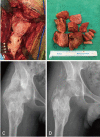Ankylosing Neurogenic Myositis Ossificans of the Hip: A Case Series and Review of Literature
- PMID: 29896457
- PMCID: PMC5990535
- DOI: 10.5371/hp.2018.30.2.86
Ankylosing Neurogenic Myositis Ossificans of the Hip: A Case Series and Review of Literature
Abstract
Purpose: Neurogenic myositis ossificans (NMO) in patients with traumatic spinal cord or brain injuries can cause severe joint ankylosis or compromise neurovascularture. The purpose of this study was to evaluate the clinical and radiological outcomes of and review considerations relevant to surgical resection of NMO of the hip joint.
Materials and methods: Six patients (9 hips) underwent periarticular NMO resection between 2015 and 2017. The medical records of these patients were retrospectively reviewed. Preoperative computed tomography including angiography was performed to determine osteoma location and size. Improvement in hip motion allowing sitting was considered the sole indicator of a successful surgery. The anterior approach was used in all patients. The ranges of motion (ROM) before and after surgery were compared.
Results: The mean time from accident to surgery was 3.6 years. Average ROM improved from 24.3°(flexion and extension) to 98.5°(flexion and extension) after surgery, and improvement was maintained at the last follow-up. No commom complications (e.g., deep infection, severe hematoma, deep vein thrombosis) occurred in any patient. Improvement in ROM in one hip in which surgical resection was performed 10 years after the accident was not satisfactory owing to the pathologic changes in the joint.
Conclusion: Surgical excision of periarticular NMO of the hip joint can yield satisfactory results, provided that appropriate preoperative evaluation is performed. Early surgical intervention yields satisfactory results and may prevent the development of intra-articular pathology.
Keywords: Heterotopic; Hip; Margins of excision; Myositis ossification; Ossification.
Conflict of interest statement
CONFLICT OF INTEREST: The authors declare that there is no potential conflict of interest relevant to this article.
Figures


References
-
- Sakellariou VI, Grigoriou E, Mavrogenis AF, Soucacos PN, Papagelopoulos PJ. Heterotopic ossification following traumatic brain injury and spinal cord injury: insight into the etiology and pathophysiology. J Musculoskelet Neuronal Interact. 2012;12:230–240. - PubMed
-
- van Kuijk AA, Geurts AC, van Kuppevelt HJ. Neurogenic heterotopic ossification in spinal cord injury. Spinal Cord. 2002;40:313–326. - PubMed
-
- Garland DE. A clinical perspective on common forms of acquired heterotopic ossification. Clin Orthop Relat Res. 1991;(263):13–29. - PubMed
-
- Garland DE. Clinical observations on fractures and heterotopic ossification in the spinal cord and traumatic brain injured populations. Clin Orthop Relat Res. 1988;(233):86–101. - PubMed
-
- Genet F, Marmorat JL, Lautridou C, Schnitzler A, Mailhan L, Denormandie P. Impact of late surgical intervention on heterotopic ossification of the hip after traumatic neurological injury. J Bone Joint Surg Br. 2009;91:1493–1498. - PubMed
LinkOut - more resources
Full Text Sources
Other Literature Sources

